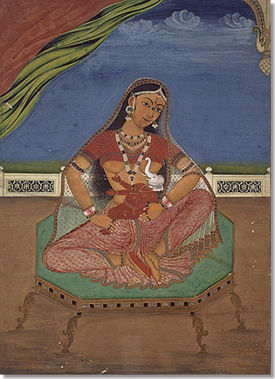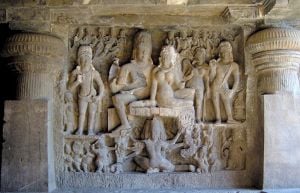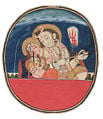Parvati
| ||||||||||||||||
Pārvatī (Sanskrit: पार्वती), sometimes spelled Parvathi or Parvathy, is a Hindu goddess. She is the wife of Lord Shiva and the divine mother of Lord Ganesh and Lord Karthikeya. Some communities also believe her to be the divine sister of Lord Vishnu who is married to Lakshmi and many of the believers of Shakta philosophy also consider her as the ultimate Divine. In many interpretations of the scriptures, Parvati is also regarded as a representation of Shakti or Durga, albeit the gentle aspect of that goddess because she is a mother goddess otherwise known as Devi . Parvati's other names include Uma, Lalitha, Gowri, Shivakamini, Aparna, the maternal epithet Mataji, and many hundreds of others; the Lalita sahasranama contains an authoritative listing.
Parvata is one of the Sanskrit words for "mountain"; "Parvati" translates to "She of the mountains" and refers to Parvati being born the daughter of Himavan, lord of the mountains. Parvati's parents are Himavat, the personification of the Himalaya mountains, and the apsaras Menā. Parvati is nominally the second consort of Shiva, the Hindu God of destruction and rejuvenation. However, she is not different from Dakshayani, being the reincarnation of that former consort of Lord Shiva.
Symbolism
Parvati symbolises many noble virtues esteemed by Hindu tradition. Just as Shiva is at once the presiding deity of destruction and regeneration, the couple jointly symbolise at once both the power of renunciation and asceticism and the blessings of marital felicity. Kalidasa's epic Kumarasambhavam details with matchlessly lyrical beauty the story of the maiden Parvati; her devotions aimed at gaining the favour of Shiva; the subsequent annihilation of Kamadeva; the consequent fall of the universe into barren lifelessness; the subsequent nuptials, in these circumstances, of the partners of many previous births; the immaculate birth of Subrahmanya and the eventual resurrection of Kamadeva after intercession by Parvati to Shiva in his favour.
Parvati thus symbolises many different virtues esteemed by Hindu tradition: fertility, marital felicity, devotion to the spouse, asceticism and power. It is said in the Saundarya Lahiri, a famous literary work on the goddess, that she is the source of all power in this universe and that because of her, Lord Shiva gets all his powers. She is occasionally depicted as half of Lord Shiva.
Famous temples
Some of the famous temples where Parvathi forms are predominantly worshipped include,
- Meenakshi temple at Madurai
- Kamakshi Amman temple at Kanchipuram
- Akilandeswari temple at Thiruvanaikaval
- Shiv-parvati.jpg
Shiva-Parvati
- Shiva parvati01.jpg
Shiva and Parvati with Ganesh
- Shiva-parvati2.jpg
The divine couple as a symbol of fertility and marital felicity
- British Museum Lalita.jpg
Parvati as Lalita with Ganesha and Skanda, in the British Museum
Shiva and Parvati, a painting from Smithsonian Institute
ReferencesISBN links support NWE through referral fees
- Hindu Goddesses: Vision of the Divine Feminine in the Hindu Religious Traditions (ISBN 81-208-0379-5) by David Kinsley
External links
- Devotional hymns and eulogies on Parvati
- Weekly podcast on Vedic Chanting and Vedic Mythology with stories from the Puranas
- Pachaivazhiamman Koil, Ariyankuppam, Pondicherry
- Temples in and around the Pondicherry
Credits
New World Encyclopedia writers and editors rewrote and completed the Wikipedia article in accordance with New World Encyclopedia standards. This article abides by terms of the Creative Commons CC-by-sa 3.0 License (CC-by-sa), which may be used and disseminated with proper attribution. Credit is due under the terms of this license that can reference both the New World Encyclopedia contributors and the selfless volunteer contributors of the Wikimedia Foundation. To cite this article click here for a list of acceptable citing formats.The history of earlier contributions by wikipedians is accessible to researchers here:
The history of this article since it was imported to New World Encyclopedia:
Note: Some restrictions may apply to use of individual images which are separately licensed.




